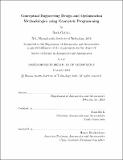Conceptual engineering design and optimization methodologies using geometric programming
Author(s)
Öztürk, Berk
DownloadFull printable version (1.317Mb)
Other Contributors
Massachusetts Institute of Technology. Department of Aeronautics and Astronautics.
Advisor
Mark Drela.
Terms of use
Metadata
Show full item recordAbstract
Geometric programs (GPs) and other forms of convex optimization have recently experienced a resurgence due to the advent of polynomial-time solution algorithms and improvements in computing. Observing the need for fast and stable methods for multidisciplinary design optimization (MDO), previous work has shown that geometric programming can be a powerful framework for MDO by leveraging the mathematical guarantees and speed of convex optimization. However, there are barriers to the implementation of optimization in design. In this work, we formalize how the formulation of non-linear design problems as GPs facilitates design process. Using the principles of pressure and boundedness, we demonstrate the intuitive transformation of physics- and data-based engineering relations into GP-compatible constraints by systematically formulating an aircraft design model. We motivate the difference-of-convex GP extension called signomial programs (SPs) in order to extend the scope and fidelity of the model. We detail the features specific to GPkit, an object-oriented GP formulation framework, which facilitate the modern engineering design process. Using both performance and mission modeling paradigms, we demonstrate the ability to model and design increasingly complex systems in GP, and extract maximal engineering intuition using sensitivities and tradespace exploration methods. Though the methods are applied to an aircraft design problem, they are general to models with continuous, explicit constraints, and lower the barriers to implementing optimization in design.
Description
Thesis: S.M., Massachusetts Institute of Technology, Department of Aeronautics and Astronautics, 2018. This electronic version was submitted by the student author. The certified thesis is available in the Institute Archives and Special Collections. Cataloged from student-submitted PDF version of thesis. Includes bibliographical references (pages 67-68).
Date issued
2018Department
Massachusetts Institute of Technology. Department of Aeronautics and AstronauticsPublisher
Massachusetts Institute of Technology
Keywords
Aeronautics and Astronautics.